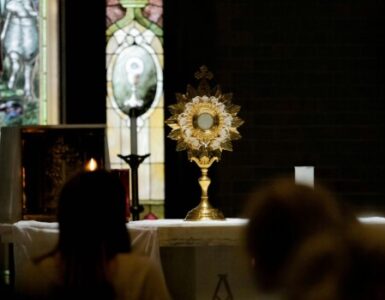
Catholic schools have been part of the American experience, possibly since 1606, when Franciscans landed with the explorers at St. Augustine, Florida, but not always this country’s public education. And there’s a reason why.
Prior to the mid-1800’s, there was no nationwide public education system in the United States. New England had a fairly developed public school system by 1850, but schools in the rest of the country were less developed, and many cities and towns had no public school at all.
Until the mid-1800’s, most Americans with money, authority, influence, and power, were non-Catholic Christians, and in New England, they were usually Puritans. Puritans were Protestants (specifically Calvinists) who thought the Church of England had retained far too many Catholic practices and beliefs when it separated from the Catholic Church in 1529. However, the Puritans’ efforts of purifying the Church of England were not as successful as they desired. Therefore, scores of Puritan ships departed for the New World with the specific intent of establishing a pure faith which was totally free of any and all things Catholic.
The Puritans landed in New England and began to set up their “city on a hill” or “New Israel”. Since a central tenet of their faith was ridding the world of Catholicism, their laws included numerous prohibitions against Catholics and Catholicism, including the death penalty for priests, prohibition from elected office, additional taxes for Catholics, and other provisions which effectively prohibited Catholics from living in New England at the time.
The Puritans were also very attentive to the education of their youth, therefore, they set up a fairly organized school system, which was run by Puritans, for Puritans, especially the children of successful Puritans. While they did allow non-Puritan students to attend their schools (the only schools in New England at the time), spots were limited, advancement was not guaranteed, and no Catholics were allowed, at least not knowingly.
Then came a man by the name of Horace Mann. Mann had grown up in a strict and dour version of the Puritan faith, then converted to Unitarianism as an adult. Mann became interested in reforming the school system in Massachusetts. He was wildly successful, and his ideas ended up spreading across the country. He is now considered the father of the American public education system.
Mann’s education reform included the requirement that all children attend school and that the curriculum included instruction on the Bible. However, being a Unitarian who did not believe the Bible to be inerrant, he established a non-sectarian approach to Bible instruction. In other words, he focused on the things on which all or most Christians agreed, and avoided the parts of the Bible where various denominations disagreed.
In essence, Mann reformed the American culture by designing a school system to which every American youth was required to attend. In addition to a cursory religious education, students were taught to be upstanding moral citizens and hard workers. The result was that the state took over the primary role of educating all children and that education expanded beyond reading, writing and arithmetic to religion and morals.
When the Catholic bishops saw that this was going to harm faith and families, they quickly concluded that it was time for a large Catholic school system as well. At that time the Bishops put faith before any worldly advancement or ideas of assimilation, because to err at such a young age in faith could have eternal consequences.
This became even more urgent as millions of Catholic Irish and Italian immigrants began to pour into the country due to conditions in Europe such as the Irish potato famine as well as other political and economic conditions in Europe at the time. The immigrants entering the U.S. in the mid to late 1800’s were mostly Catholic, and almost all of them were also very poor and uneducated. They would have been very susceptible to leaving the Catholic faith in a Protestant culture which still looked down on Catholicism and which ran a school system which was designed to assimilate children into a Protestant culture.
Mann’s model still prevails in the public education system in the U.S. However, the U.S. is no longer Protestant, nor is it Christian. In fact, many public school administrators and boards fear lawsuits and public outcry so much, they often suppress Christianity in their school and give preferential treatment to LGBT groups, atheists, radical feminism, and other ideologies which conflict with Christianity. When a Christian or a Christian group attempts to challenge a school administration’s discrimination against a Christian, people often use fear of Satanic clubs and groups as justification: “If we allow you to use school property for your Christian activity, we’ll have to allow the use of our property for Satanist clubs.”
This brings us to the reason why Catholic schools are the perfect answer to today’s problems. Catholic schools were designed to keep parents in the role of primary educator of their children with regard to faith and morals, to support the family, and to avoid the loss of the Catholic faith through assimilation into the Protestant melting pot of American culture. All of these purposes are still highly relevant, though the melting pot is no longer Protestant, it is now mostly pagan. In reality, Satan is already alive and well in many public schools.
Unfortunately, many Catholic schools struggle to deliver an authentic and faithful Catholic experience these days. However, this is not necessarily the fault of the school. I believe it is usually the result of the lack of the authentic living out of the faith by Catholic parents and families who send their children to that Catholic school. The school’s decline in its ability to, or interest in, transmitting the faith, is usually the result of years of apathy within the homes and lives of the individual Catholics associated with the school. How can we expect a school to teach, practice, and inspire, the authentic practice of the Catholic faith, if we ourselves, are not living the faith out in our homes? When a certain percentage of families are not living the faith in their private lives, it will naturally impact the school. In the same way, when a certain percentage of families are living their faith authentically, it will positively impact the school.
The key is to be the primary educator of your own child (especially fathers) with regard to faith and morals, which of course presumes that you are living the faith and actually know why we believe what we believe. Therefore, if you need a little catechesis and deepening of your faith, now is the time to do that. The bottom line is this: The school should only be in a supportive role to the parent. We cannot hand this obligation over to any outside entity or individual (including our wives) and expect good results.
For some of us, this means that we have to homeschool our children. Homeschooling is perfectly compatible with the Catholic faith. As a matter of fact, prior to about 1850, nearly every Catholic child was homeschooled in the U.S., because Catholics were either excluded from schools or no school existed.
The purpose of this article is not to claim that you must send your Catholic child to a Catholic school. Nor is it to encourage homeschooling. The purpose is to show a little about the reason we have Catholic schools, how we should approach Catholic education as parents, and thereby encourage a new perspective on how to reform Catholic education in your parish or community so there is absolutely no reason not to send your child to a Catholic school.
We are not there yet, but we need to be there, and we can get there. The way we get there is by deepening our faith as parents and by living our faith as families. When we assume our role as the primary educator of our children, Catholic school education will work as it is designed, and it will work well. At that point, the only question will be: Do we send our kids to Catholic school, or do we homeschool? Public education will be out of the question unless the parents live in a location where no Catholic school exists, and they are not capable of homeschooling for one reason or another.
The post Why Catholics Didn’t Go to Public School “Back Then” And Probably Shouldn’t Now appeared first on Those Catholic Men.
This article is reprinted with permission from our friends at Those Catholic Men.











